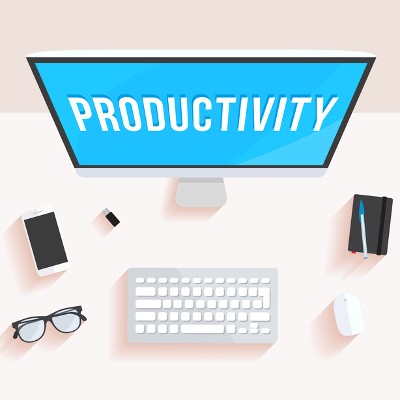Technology plays a pivotal role in the operations of most businesses, but its primary function is to empower and support the workforce. Many employees have specific expectations when it comes to the technology provided by their organizations. Failure to meet these expectations can drive them to seek employment elsewhere. Let’s delve into five ways technology bolsters your employees' productivity.
EZ MSP Blog
Starting a business is certainly no easy feat. It was likely a hassle just to get things up and running at a basic level. While most organizations that provide a product likely had to focus on getting that product to market, technology has begun to help aid this endeavor considerably. Unfortunately, it’s easy to fall into the trap that your organization uses too much technology--so much that it negatively affects your bottom line.
Productivity is a major consideration in any business environment - that’s largely why so many solutions designed for a business’ use focus on increasing productivity as much as possible. One method of doing so that many businesses have found effective is the adoption of Unified Communication and Collaboration solutions.
Business owners know that streaming in the office can be a considerable detriment to productivity, but the type of media that is being streamed can play a large role in whether or not the workplace is enhanced or affected adversely by it. How does your organization approach streaming? Depending on its policies, you might want to change the way that you approach this touchy subject.
Spring seems to be the natural time, after what are commonly dreary winter months, to revitalize and refresh your environment - why shouldn’t your business be included? Not only does it help your operations, a clean environment also has many direct benefits for your employees. Let’s review the effects of keeping your business, and its technology, in order.
The holidays are a time when everyone questions whether they will be able to spend their time at home with their families, or be stuck at the office trying to beat a nasty deadline. The increase in mobile technology hasn’t made getting away from work any easier, but it has made it easier to work away from the office. However, this constant access to work resources may enable your work to encroach upon your personal time. How can you achieve a precious work/life balance for your workplace duties?
When people talk about a business’ efficiency, it’s typically referring to the ability for the organization to bring a product or service to market quickly with a small amount of wasted resources. The prevailing theory is that an efficiently-run business costs less, makes more, and grows faster than one that is inefficient. With the way business is headed--that is, with smaller profit margins than ever before--boosting efficiency has become a core business strategy. In fact, in today’s technology-driven marketplace, there are many that would argue that the efficient business is the only good business.
So, you’ve just finished up a huge, potentially career-altering project. Your finger is poised over the mouse, ready to click ‘save,’ when suddenly your entire project disappears. Turns out, a critical issue just killed your network, your progress, and your mood. Wouldn’t it be nice if there was a way to keep this from happening?
Virtualization is changing the way that businesses access information, to the point where many organizations simply choose to store their data infrastructure in the cloud and access it as needed. While this is extremely convenient and helps to keep your in-house wiring to a minimum, it also puts you at the mercy of your business’s Internet connection. You don’t need us to tell you that this is a precarious situation to be in, and the slightest Internet hiccup could cause a world of trouble.
 Most modern businesses need access to crucial parts of their infrastructure in order to keep operations moving forward. For example, your building’s electricity is necessary to power your technology, and without an Internet connection, you could be losing out on hours of potential productivity. What can you do to minimize downtime and make the best out of a bad situation?
Most modern businesses need access to crucial parts of their infrastructure in order to keep operations moving forward. For example, your building’s electricity is necessary to power your technology, and without an Internet connection, you could be losing out on hours of potential productivity. What can you do to minimize downtime and make the best out of a bad situation?
 How many of your employees have a smartphone? The answer is probably most (if not all) of them. In the United States alone, nearly two-thirds of adults own a smartphone, and many of them depend on the device to do much of their personal computing. As a result, many workers, even if they are instructed not to, will use their devices while at your office. This is why many companies have put in place a comprehensive Bring Your Own Device (BYOD) strategy.
How many of your employees have a smartphone? The answer is probably most (if not all) of them. In the United States alone, nearly two-thirds of adults own a smartphone, and many of them depend on the device to do much of their personal computing. As a result, many workers, even if they are instructed not to, will use their devices while at your office. This is why many companies have put in place a comprehensive Bring Your Own Device (BYOD) strategy.
 What’s your reaction to your mobile device beeping at you? If you’re the kind of person that drops everything to see what it says, then you’re probably way more distracted at work than you should be. It’s a bad habit to look at your phone every minute or two, but with hard work, habits can be broken. Here are three actions you can take to minimize workplace distractions so you can be more productive.
What’s your reaction to your mobile device beeping at you? If you’re the kind of person that drops everything to see what it says, then you’re probably way more distracted at work than you should be. It’s a bad habit to look at your phone every minute or two, but with hard work, habits can be broken. Here are three actions you can take to minimize workplace distractions so you can be more productive.
 There are a lot of ways to boost your productivity in the workplace, but sometimes it can be as simple as not working. According to a study by Julia Gifford of Draugiem Group, it’s not about what workers do to get ahead of the curve, but what they don’t do that sets them apart from others around them.
There are a lot of ways to boost your productivity in the workplace, but sometimes it can be as simple as not working. According to a study by Julia Gifford of Draugiem Group, it’s not about what workers do to get ahead of the curve, but what they don’t do that sets them apart from others around them.
 Smartphones and tablets are the new norm. Most professionals have begun to utilize mobile devices to accomplish tasks when they are away from their work PC. Not to say that these devices offer all that much in the way of productivity. Sure, there are plenty of software titles either ported over from the PC or developed directly for the mobile environment, but sometimes these titles don’t offer the functionality, or they take up too many of the device’s resources to be of much use. With these variables to consider, manufacturers are searching for the best way to deliver devices with enhanced productivity capabilities, right out of the box. One of these manufacturers is Microsoft.
Smartphones and tablets are the new norm. Most professionals have begun to utilize mobile devices to accomplish tasks when they are away from their work PC. Not to say that these devices offer all that much in the way of productivity. Sure, there are plenty of software titles either ported over from the PC or developed directly for the mobile environment, but sometimes these titles don’t offer the functionality, or they take up too many of the device’s resources to be of much use. With these variables to consider, manufacturers are searching for the best way to deliver devices with enhanced productivity capabilities, right out of the box. One of these manufacturers is Microsoft.
 The open office is convenient for a number of reasons. It is far more space-efficient, and it makes collaboration easier among coworkers. However, did you know that the open office can make people worse at their jobs? In 2002, a study in the journal Environment and Behavior tracked employees as they were moved from a private office to the open office, and the results were less than desirable.
The open office is convenient for a number of reasons. It is far more space-efficient, and it makes collaboration easier among coworkers. However, did you know that the open office can make people worse at their jobs? In 2002, a study in the journal Environment and Behavior tracked employees as they were moved from a private office to the open office, and the results were less than desirable.
 When it comes down to it, your employees are being paid for their time spent at work. Business operates on the principle of “time is money,” which means that every minute wasted cuts into your bottom line. If you’re looking to squeeze the most productivity out of your employees, then there are technologies available that can take back those precious minutes.
When it comes down to it, your employees are being paid for their time spent at work. Business operates on the principle of “time is money,” which means that every minute wasted cuts into your bottom line. If you’re looking to squeeze the most productivity out of your employees, then there are technologies available that can take back those precious minutes.
 We’re all aware of how the proliferation of mobile devices is changing the workplace, but let’s take an objective look at this trend. Are mobile devices changing the workplace for the better? Are employees actually using their personal devices to get more work done? Or, is the BYOD trend a bunch of hype and nothing’s really changed? Let’s find out.
We’re all aware of how the proliferation of mobile devices is changing the workplace, but let’s take an objective look at this trend. Are mobile devices changing the workplace for the better? Are employees actually using their personal devices to get more work done? Or, is the BYOD trend a bunch of hype and nothing’s really changed? Let’s find out.
 A business owner knows better than anyone how difficult it can be to manage their time and get the most out of their workday. However, you can use your morning and afternoon commutes to eliminate certain mundane tasks from your day-to-day schedule. By using this time to your advantage, you can reduce the stress you’re put under on a daily basis and free your schedule for more important tasks.
A business owner knows better than anyone how difficult it can be to manage their time and get the most out of their workday. However, you can use your morning and afternoon commutes to eliminate certain mundane tasks from your day-to-day schedule. By using this time to your advantage, you can reduce the stress you’re put under on a daily basis and free your schedule for more important tasks.











